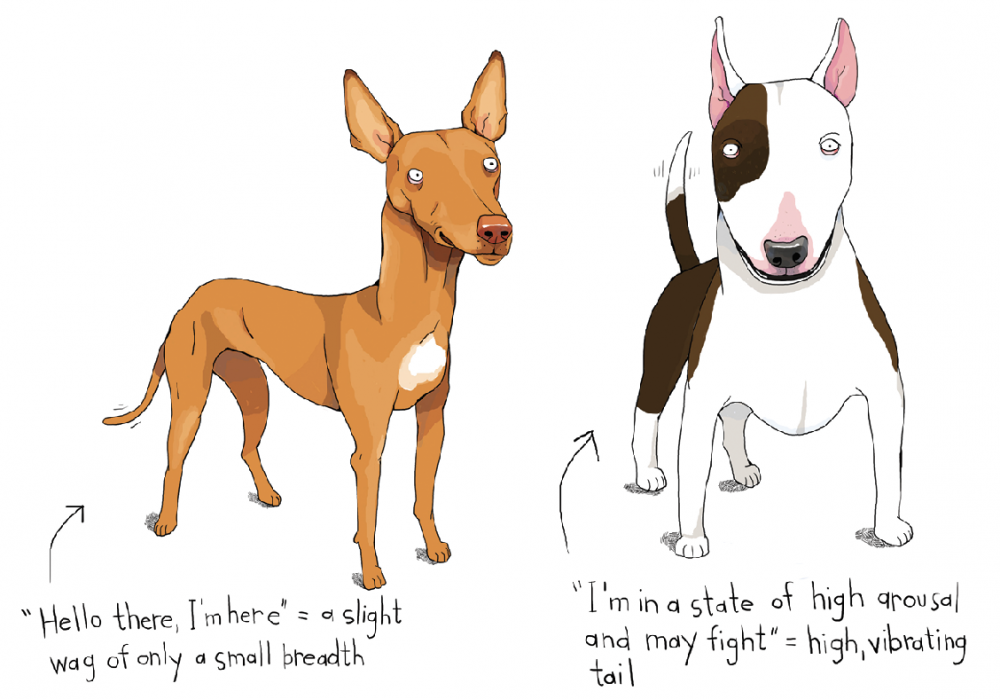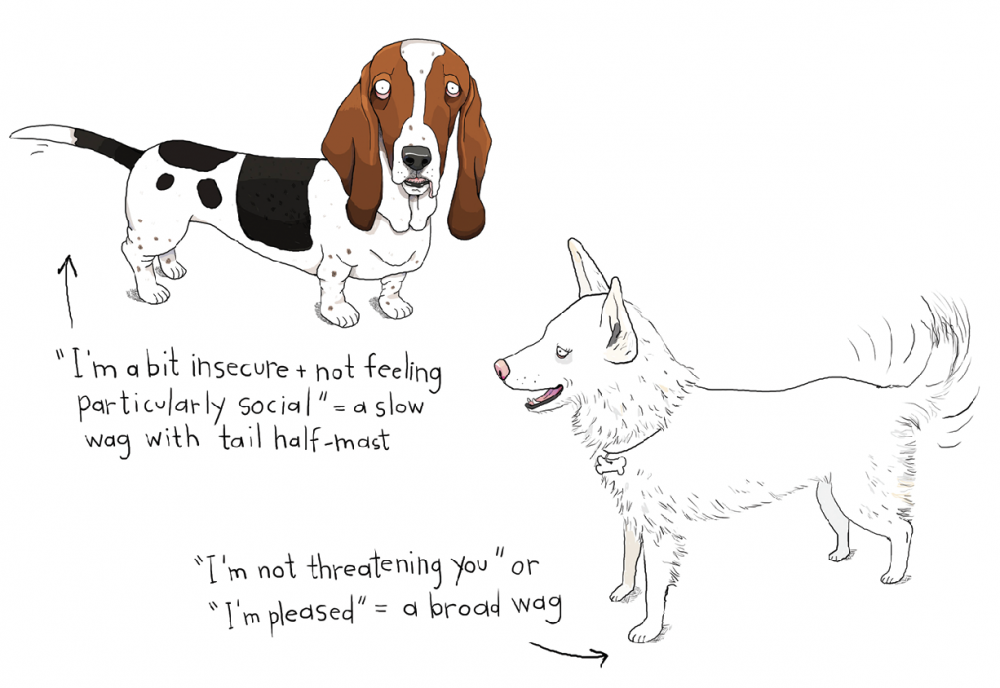Balance, communication, pheromone distribution… your dog’s tail does it all!
Ever wonder why your dog has a tail? It turns out there are many good reasons!
The dog's tail was originally designed to assist in balance, keeping a running dog on course when he turns. When a dog is running and has to turn quickly he throws the front part of his body in the direction he wants to go. His back then bends but his forward velocity is such that his hind quarters will tend to continue in the original direction. Left unchecked, this movement might result in the dog's rear swinging widely which could greatly slow his rate of movement or even cause the dog to topple over as he tries to make a high speed turn. Throwing his tail in the same direction that his body is turning serves as a sort of counter weight which reduces the tendency to spin off course.
Dogs also use their tails for balance when walking along narrow surfaces, much the same way that a circus tightrope walker uses his balance bar. However, the tail is not particularly important when simply standing around on flat surfaces or walking at normal speeds. Evolution seized upon this opportunity and co-opted the tail at those times for communication purposes.
For most breeds of dogs the tail is easily seen and serves as a sort of signal flag that communicates information about the animal's emotional state. A number of breeds, such as the Beagle, even have tails with a white tip to help increase their visibility. Variables such as how high the dog carries his tail, how quickly the dog is moving his tail, and even whether the tail is being wagged more to the left or right side of the body can convey a lot of information about how the dog is feeling, his mood, and even his intentions. Dogs with very short tails, either because of the nature of their breed (for example the French Bulldog is born with a little stump of a tail about one inch in length) or because their tails have been docked, cannot communicate as well; such dogs often have difficulties interacting with other canines.

The tail's position, specifically the height at which it is held, can be considered a sort of emotional meter. A middle height suggests the dog is relaxed. If the tail is held horizontally, the dog is attentive and alert. As the tail position moves farther up, it is a sign the dog is becoming more threatening, with a vertical tail being a clearly dominant signal: "I'm boss around here," or a warning, "Back off or suffer the consequences."
As the tail position drops lower, it is a sign that the dog is becoming more submissive, is worried, or feels poorly. The extreme expression is the tail tucked under the body, which is a sign of fear: "Please don't hurt me."
Just as there are different dialects to a human language, such as a southern drawl or a New England twang, there are also dialects in dog tail language. Different breeds carry their tails at different heights, from the natural nearly vertical position common to Beagles and many Terriers to the low-slung tails of Greyhounds and Whippets. All positions should be read relative to the average position where the individual dog normally holds its tail.
How to Read Your Dog's Tail
Movements give additional meaning to the signals. The speed of the wag indicates how excited the dog is. Meanwhile, the breadth of each tail sweep reveals whether the dog's emotional state is positive or negative, independent from the level of excitement.
As a result, there are many combinations, including the following common tail movements:
A slight wag, with each swing of only small breadth, is usually seen during greetings as a tentative, "Hello there," or a hopeful "I'm here."
A broad wag is friendly: "I am not challenging or threatening you." This can also mean: "I'm pleased." This is the closest to the popular concept of the happiness wag, especially if the tail seems to drag the hips side to side with it.
A slow wag with the tail at half-mast is less social than most other tail signals. Generally speaking, slow wags with the tail in neither a particularly dominant (high) nor a submissive (low) position are signs of insecurity.
Tiny, high-speed movements that give the impression of the tail vibrating are signs the dog is aroused and about to do something, usually run or fight. If the tail is held high while vibrating, it is most likely an active threat.
We can now add another newly discovered feature of dog tail language that may surprise attentive pet owners as much as it surprised scientists like me. It now appears that when dogs feel generally positive about something or someone, their tails wag more to the right side of their rear ends, and when they have negative feelings, their tail wagging is biased to the left. (We are talking about the dog's left or right, viewed from the rear as if you are facing in the direction the dog is viewing.)
Beyond providing a visual signal that displays emotional information, tails also have another important role in communicating: every time your dog moves his tail, it acts like a fan, spreading the dog’s unique scent around. These smells, called pheromones, are designed to communicate information between animals. Some important pheromones come from the anal glands which are two sacs located under the tail; the anal sacs’ odour is as unique among dogs as fingerprints are for people. When dogs wag their tails, muscles contract and press on these glands, causing a release of some of the scent. A dominant dog who carries her tail high will release much more scent than a dog who holds his tail lower. The dominant dog's tail wags will spread her scent around announcing, “I am here,” whereas a frightened dog holding his tail between his legs covers the anal glands. Thus, his scent doesn’t spread around and he does not draw unwanted attention to himself.

It is something of a surprise to many people to learn that puppies do not wag their tails when they are very young. The youngest puppy I ever saw systematically wagging her tail was 18 days old, and both the breeder and I agreed that this was quite an unusual case. Although there are some differences among the various breeds, the scientific data suggests that, on average, by 30 days of age about half of all puppies are tail wagging and the behaviour is usually fully established by around 49 days of age.
Why does it take so long for the puppy to start wagging his tail? The answer comes from the fact that puppies begin tail wagging when it is needed for purposes of social communication. Until they are about three weeks of age, puppies mostly eat and sleep. They are not interacting significantly with their littermates other than when curling up together to keep warm when they sleep, or crowding together to nurse. They are physically capable of wagging their tails at this time, but they don't.
By the age of six or seven weeks or 42 to 49 days (when we start to see tail wagging behaviours on a regular basis) the puppies are now socially interacting with one another. Most of the social interactions in puppies are what psychologists call play behaviours. It is through playing that puppies learn about their own abilities, how they can interact with their environment, and most importantly, how to get along with other individuals. Thus the pup learns that if he bites a littermate he is apt to be bitten back, and perhaps the game that he was playing might be terminated by its now-angry playmate. It is at this point that the puppy also starts to learn dog language. It is not clear to what degree these emerging social communications are pre-wired, but learning is clearly needed to refine the use and interpretation of these signals. The pups learn to connect their own signals and the signals provided by their mother and their siblings with the behaviours that come next. They also begin to learn that they can use signals to indicate their intentions, and to circumvent any conflicts. This is where and when the tail wagging behaviour begins.
One place where conflicts are likely to occur is during feeding. When a puppy wants to suckle her mother, she must come very close to her littermates who might have been nipping, jostling or chasing her a few minutes earlier as they all crowd in to find a teat. To indicate that the current situation is a more peaceful one and to calm any fearful or aggressive response by the other puppies, the puppies begin to wag their tails. Tail wagging in puppies thus serves as a truce flag to littermates. Later on, puppies will begin to wag their tails when they are begging food from the adult animals in their pack or family. As the puppies come close in order to lick the face of the adult dog, they signal their peaceful intentions by tail wagging. Thus it’s clear that the reason that very young puppies don't wag their tails is that they don't need to send appeasement signals to other dogs yet. When communication between dogs begins to be needed, however, they rapidly learn the appropriate wagging signals, putting that marvellous tail to use!
No comments:
Post a Comment